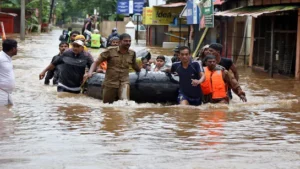GS III-DISASTER MANAGEMENT

Disasters: Mechanisms and Funding
Natural disasters pose significant challenges to states, often overwhelming their capacity to respond effectively. To mitigate the impact, India has established a structured disaster management framework under the Disaster Management Act, 2005 (DMA), which provides both institutional and financial support to states facing such crises.
Institutional Framework for Disaster Management
The Disaster Management Act, 2005, enacted in the wake of the devastating 2004 Indian Ocean tsunami, defines a disaster as any event—natural or man-made—that causes severe human suffering, property damage, and environmental degradation beyond the capacity of the affected community to manage.
To ensure a coordinated disaster response, the Act established:
- National Disaster Management Authority (NDMA): The apex body for disaster response and mitigation, headed by the Prime Minister.
- State Disaster Management Authorities (SDMAs): State-level agencies responsible for disaster preparedness and response.
- District Disaster Management Authorities (DDMAs): Local authorities managing disaster relief at the grassroots level.
Together, these institutions form an integrated disaster management network that enables both immediate relief and long-term disaster preparedness.
Financial Assistance to States for Disaster Relief
States facing natural disasters receive financial assistance from two primary sources:
- State Disaster Response Fund (SDRF)
- National Disaster Response Fund (NDRF)
Both funds were established under the Disaster Management Act, 2005, ensuring a structured approach to disaster relief funding.
National Disaster Response Fund (NDRF): A Safety Net for Severe Disasters
What is the NDRF?
Originally known as the National Calamity Contingency Fund (NCCF), the National Disaster Response Fund (NDRF) was formalized through the Disaster Management Act, 2005 under Section 46.
- Managed by the Central Government, the NDRF is designated to cover emergency response, relief, and rehabilitation expenses for severe disasters.
- It serves as a supplementary fund to the State Disaster Response Fund (SDRF) when a state lacks adequate resources to handle a large-scale calamity.
How are NDRF Funds Released to States?
- Requesting Assistance from NDRF
- If a disaster exceeds the state’s capacity, and SDRF funds are insufficient, the state government can formally request additional assistance from the NDRF.
- Evaluation and Assessment
- The Ministry of Home Affairs (MHA), or the Ministry of Agriculture (for specific disasters like drought), evaluates the request.
- The assessment follows a structured process as outlined in the Operational Guidelines for the NDRF (2022), which govern fund allocations for the fiscal years 2021-22 to 2025-26.
- Formation of the Inter-Ministerial Central Team (IMCT)
- The MHA constitutes an Inter-Ministerial Central Team (IMCT), which conducts an on-ground assessment of the affected areas.
- Based on its findings, the IMCT recommends whether additional funds should be released.
- Decision-Making Process
- A Sub-Committee of the National Executive Committee (NEC), comprising secretaries from relevant ministries, deliberates on the IMCT report and decides on fund allocation.
- Finally, a High-Level Committee (HLC), chaired by the Union Home Minister, along with the Ministers of Finance and Agriculture, and the Vice-Chairman of NITI Aayog, approves the release of NDRF funds.
State Disaster Response Fund (SDRF): The Primary Disaster Relief Fund
Overview of SDRF
The State Disaster Response Fund (SDRF), constituted under Section 48(1)(a) of the Disaster Management Act, 2005, is the first line of financial defense for states in responding to natural disasters.
- Established on the recommendation of the 13th Finance Commission, the SDRF is the primary reserve available to state governments for immediate relief measures.
- The fund is audited annually by the Comptroller and Auditor General (CAG) of India to ensure transparency.
Centre-State Contribution to SDRF
- General Category States & Union Territories: 75% Central Government, 25% State Government.
- Special Category States & Union Territories (Northeastern states, Sikkim, Uttarakhand, Himachal Pradesh, Jammu & Kashmir): 90% Central Government, 10% State Government.
Disasters Covered Under SDRF
The SDRF provides relief for major natural disasters, including:
- Cyclones
- Droughts
- Earthquakes
- Fires
- Floods
- Tsunamis
- Hailstorms
- Landslides
- Avalanches
- Cloudbursts
- Pest Attacks
- Frost & Cold Waves
Provision for Local Disasters
- Up to 10% of the SDRF funds can be allocated by the State Government for relief measures in case of localized disasters that are not included in the official notified disaster list of the Ministry of Home Affairs.
Conclusion: A Multi-Layered Approach to Disaster Response
India’s disaster management framework is built on a multi-tiered approach, with clearly defined institutional mechanisms and financial resources to support states during emergencies.
- The SDRF serves as the first line of defense, empowering states to address localized disasters.
- When calamities exceed state capacities, the NDRF steps in to provide additional financial aid through a structured process involving multi-agency assessment and high-level approval.




